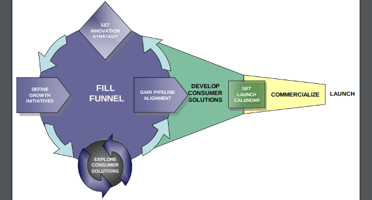I was recently chatting with my boss (also a former CPG marketer) about innovation. I remembered...
Is your business proprioceptive?

About 10 years ago, I was out for a run with my dog when another dog lunged at us. And that is how I ended up limping home on two sprained ankles. It was one of the doctors who mentioned that I might experience issues with “proprioception” even after the injury had healed. Ever since then, I’ve been obsessed with the idea of "proprioception" as a powerful analogy for what happens with business strategies.
What is proprioception?
Proprioception is one’s sense of self-awareness. It refers to the subconscious sense that allows you to think up an idea, like “I need a snack,” and then make it happen without having to manage the details, e.g. “first I will move my right foot, then my left foot.” With proprioception, you’re suddenly at the refrigerator getting your snack. Without proprioception, every action would become a complex calculation. This is what the doctor was talking about. When you sprain your ankles, for example, actions become slower because of all of the conscious, awkward coordination needed to compensate for the injury.
I can happily say that my ankles healed. But, the idea of “proprioception” stuck with me. How might this concept apply to businesses?
Proprioceptive in business: Turning Strategy into Action
Is it possible for something as complex as a corporation to be “self-aware” or “proprioceptive” such that a strategic thought created by leadership translates into seamless coordination and action? What conditions would need to be met to make this sort of “unconscious” alignment happen?
I believe there are four pieces of the puzzle to align in order to reach this level of “self-awareness”: Strategy, Brand, Analytics, and Execution - the brains, heart, nervous system and muscles of a business.
-
- Strategy: Do we know what we are trying to accomplish?
This is the traditional strategy stuff: Missions, Visions, Objectives, KPIs/OKRs. This work has to be done to give the organization direction. The problem is that it often stops here. Everyone retreats to their functional silos , interprets the strategy and then does something, coordinated or not. - Brand: Do we communicate a compelling message that inspires both employees and customers?
“Brand” is often seen as a marketing function, which is unfortunate. “Brand” is about defining a real problem that customers have and then promising a solution to that problem. Using compelling advertising to make that promise is only one component. Employees also have to be inspired to ensure that the company consistently delivers on that promised experience. - Analytics: Are there effective feedback mechanisms?
In order for the business to deliver on strategy and goals, there have to be defined mechanisms for understanding an ever changing landscape of macroeconomic, industry, competitive, and internal factors. To continuously adapt to these, there needs to be constant feedback flowing from and to all parts of the organization. Ultimately, it's about getting the right information to the right people at the right time to make the right decisions. - Execution: Are employees empowered with tools, training and authority to deliver on strategies and business goals?
It’s not enough to say we are going to execute strategy. Significant thought is required into how to create the conditions where employees do what needs to be done. Can the business make the path to meeting goals into a path of least resistance? Doing this right will not look like top down micromanagement. Instead, it is about defining rules in such a way that the desired results “emerge” from the bottom up.
- Strategy: Do we know what we are trying to accomplish?
You might look at these 4 elements and think, “Of course, every company does these things.” And yet, I am sure everyone can point to multiple occasions where a company put a strategy on paper (or into PowerPoint), and nothing happened. Why? Because we often stop with the strategy and then tell functional leaders, “Go do it.” I believe the missing piece is culture.
Culture: Does the company embrace coordination and alignment?
A culture that merely delegates the work and demands results is not proprioceptive. It may function admirably well in many situations, but it cannot easily adapt to new challenges (like a global pandemic, for example). The culture must plan, train and celebrate collaboration, coordination and alignment so that desired behaviors emerge. As much time, perhaps more, should be spent on understanding the intersections between functions as is invested in the operation of silos.
I believe with enough thoughtful planning, a proprioceptive business is possible. If nothing else, sometimes a good analogy is just what is needed to start the right dialogue. Just asking the questions above may reframe business strategy from a paper exercise to real life actions.
If you decide you want a thought partner to help, shoot me a note. I’m obsessed with this stuff: jeff.sigel@proprioceptive.io or check out www.proprioceptive.io



